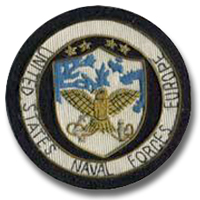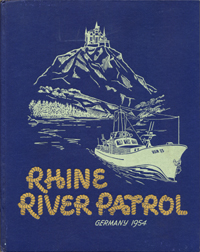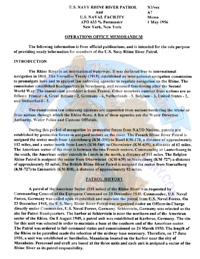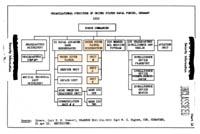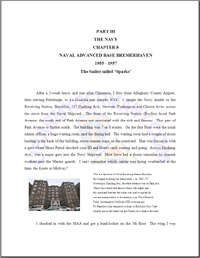Rhine
River Patrol
Commander
Naval Forces Germany
Looking for more information from military/civilian
personnel assigned to or associated with the U.S. Army
in Germany from 1945 to 1989. If you have any
stories or thoughts on the subject, please email me (webmaster).
|
|
|
|
|
| |
| History |
| |
| 1949 |
| (Source: Annual
Narrative Report, 1949, HQ EUCOM) |
Establishment
of the Rhine River Patrol
The Rhine River Patrol was activated in March (1949) as an inland
water patrol under the command of the Commander, US Naval Forces,
Germany, with certain US Constabulary personnel attached. The creation
of this command was authorized in December 1948 when COMNAVFORGER
was directed to establish a Rhine River Patrol to operate from the
vicinity of Bingen to Karlsruhe, Germany. The patrol consisted originally
of eleven craft -- one air-sea rescue craft and ten TF's (German Torpedo
Recovery Boats). Naval strength for the patrol was composed of eight
crews of seven men each and a small command group. The US Constabulary
supplied three additional men per crew, one machine-gunner and a two-man
demolition team. This personnel breakdown and the inland nature of
the patrol was indicative of the co-operation between EUCOM and USNAVFORGER
in 1949.
Control, Administration, and Support
Although COMNAVFORGER was charged with the normal command responsibility
for the patrol, the Commanding General, US Constabulary, was to assume
operational control in the event of an emergency. Administratively,
there was complete co-operation between EUCOM and USNAVFORGER. Requests
for facilities, services, and supplies (less organizational equipment)
which could not be met by the Navy, Wiesbaden Military Post, or other
posts on which the Patrol might be based, were submitted to the Logisitics
Division, EUCOM Headquarters, together with estimated costs. The major
requests made through the Logisitics Division during 1949 were for
funds for construction of a cinder block-house and for conversion
of a barge for billeting and offices. In addition, COMNAVFORGER submitted
to the OPOT Division through the US Constabualry a request for certain
items of organizational equipment not provided by the Navy. The OPOT
Division published an Equipment Modification List covering the needs
of the Rhine River Patrol and authorized the 54th Engineer Combat
Battalion to draw this equipment for use by the Patrol on a loan basis.
The material supplied consisted of engineer, ordnance, and signal
equipment. The Patrol also submitted recommendations for a basic load
of ammunition, which was established on 13 January 1950, and for training
requirements necessary to accomplish its mission. In each case action
was taken by the Requirements, Organization, Equipment, and Movements
(ROEM) Branch of the OPOT Division and by the Logisitics Division,
EUCOM Headquarters.
Operation of the Patrol
Although the major activity of the patrol in joint operations was
its participation in Exercise
HARVEST, it also took part in a joint maneuver by the US Constabulary
and the French Army of Occupation in late September. In this maneuver,
the Rhine River Patrol moved elements of the 1st Armored Cavalry Brigade
across the Rhine River. During the year, it also engaged in Command-level
training, routine patrolling of the Rhine, setting up supply channels
through EUCOM installations, and maintaining close liaison with military
posts on which its units were based. |
| |
| Rhine River
Patrol Area of Operations |
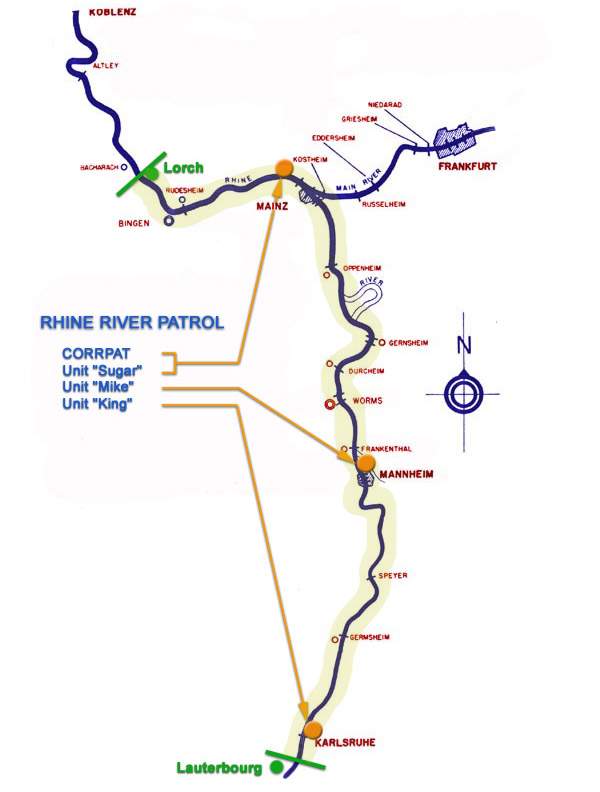 |
|
| |
| |
RRP Article
All Hands Bulletin
|
|
|
|
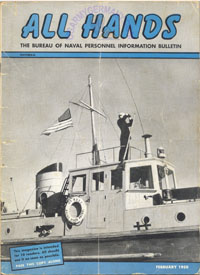
1. Cover |
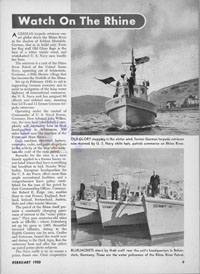
2. Page 1, 2 of article |
|
|
|
|
|
| 1952 |
| (Source: STARS & STRIPES, Oct 26, 1952) |
Rhine Patrol Gets 2 New River Craft
Two Navy utility landing craft slated for service with the Rhine River Patrol were commissioned in Bremerhaven recently in brief ceremonies at Torpedo Quay.
Capt. John G. McClaughry, commanding officer of the US Naval Advanced Base in Bremerhaven, formerly turned over the new vessels to Navy Lt. Vincenzo Lopresti, who represented Capt. B. A. Robbins, CO of the patrol unit.
Lopresti then ordered the colors raised and officially put the vessels in commission.
The vessels, named the LCU 779 and LCU 1174, were shipped to Bremerhaven from Jacksonville, Fla. They were assembled in three weeks by the Navy ship repair department.
Powered by three Diesels and driven by three propellers, each ship is about 100 feet long.
|
|
| |
| 1954 |
| (Source: Rhine River Patrol Cruise Book 1954) |
RHINE RIVER PATROL
The legendary Rhine Valley is today a fascinating operations area for hundreds of American sailors. These mariners, serving more than 300 miles from the nearest salt water, are members of the United States Navy's most unusual flotillas -- the Rhine River Patrol.
Primarily a tactical arm, the patrol is responsible for the security of the United States Zone of Germany along the Rhine and for water communications of United States and North Atlantic Treaty Organization forces. Its mission is to control river traffic from Lauterbourg in the south to Lorch, about 100 miles north. Lauterbourg, the upstream terminus, lies at the border of the French Zone and at the head of the Black Forest. Lorch, deep in the heart of the castle country downstream, is close to the famed Rock of Lorelei and 35 miles from Coblenz, headquarters of American occupation forces after World War I.
The Rhine is one of the world's busiest inland waterways. It is estimated that about 88,000,000 tons of cargo will move up and down the river during the year, placing its tonnage well above that of the Mississippi. The biggest single item of commerce is coal from the Ruhr Valley. Some 28,000,000 tons will be shipped this year. |
|
|
It is the job of the patrol to check all commercial vessels and log them as to type and nationality. Over 8,000 were recorded in 1952. At the same time, the patrol notes and reports changes in currents, channels and river depths. Our sailors have learned that there are no short cuts to mastering river navigation. High water from the snowy Alps frequently causes trouble. The swift, changing currents gouge and alter the underwater topography, leaving new channels which must be designated on navigation charts.
Shorelines are troublesome too. They have been lined with paving stones placed thereby the Germans to protect the land from washing away in the high water. To avoid damage, landing craft must be handled carefully when loading or unloading.
Besides controlling commercial traffic along the American sector of the Rhine, the patrol protects bridges and other structures, provides supplementary ferry service, carries on salvage operations and fire control support. During United States-Allied field exercises, the patrol ferries ground troops and material across the Rhine, maintains floating guards at bridges, and occasionally carries out simulated demolitions as part of its training duties. |
|
|
The Rhine is not a new sphere for the Navy.
During World War II assault and landing vessels with navy crews were hauled overland from Channel ports on the Atlantic and launched from the west bank of the Rhine. After the war the Navy withdrew and did not return until 1948. In December of that year the Rhine River Patrol was established.
Today the patrol has three operating sections. Headquarters and Unit "S" are at Schierstein, a harbor community close to Wiesbaden. The second, Unit "M", is based at Sandhofen, near Mannheim. The third, Unit "K" is at Karlsruhe near the southern terminus.
Several types of craft are used. Newest and fastest are the 80-foot, twin-screw speedsters called PRs, (Patrol, River). By degrees these are replacing the old German torpedo-retriever boats (torpedo-fangboot) which the patrol has been using. With a top speed of 27 knots, the new silvergray craft were built in German shipyards to United States Navy specifications. Plans called for an underside exhaust and no stack, but the German builders were more than skeptical. "They were amazed," one of our Navy men recalls. "They didn't think it could be done because they had never done it before. But we told them that in America. vessels with underside exhausts and no stacks are common. We finally got the boats without the stacks."
Workhorses of the patrol are the LCUs (Landing
Craft, Utility), formerly British craft, which are used chiefly for ferrying operations. They can transport five heavy tanks or 250 tons of cargo. During 7th Army field exercises the LCUs ferry vehicles and troops across the river.
Two other types of smaller ferrying craft are in use. The LCM (Landing Craft, Medium) can carry one medium tank or about 30 tons. Slightly larger than the LCMs are the LCM-RRs (Rhine River), which were constructed in Germany under American Navy direction. Built to meet the peculiar requirements of the Rhine River shoreline, the LCM-RRs can carry one heavy tank or 60 tons of cargo.
Ferrying operations keep the patrol busy. During Army and Air Force training exercises, the major loads are bulldozers, trucks, bridge-building equipment, and supplies. Alled vehicles, too, are accommodated. In one recent operation the patrol shuttled a large number of French Army tanks and trucks across the waterway.
Special ferrying tasks are handled by an awkward looking craft known as the Siebel Ferry. Built by the Germans (in WWII) to carry tanks on the Mediterranean and on Italian rivers, they are self-propelled rafts with parallel pontoons, planked decks and retractable loading ramps on two sides.
Crews vary according to the type of patrol vessel.
The fast PRs have an all-American Navy crew of five, commanded by a boatswain's mate first class. Each LCU carries a 16 to 22-man mixed American Navy and German crew. The Germans are members of the Labor Service Organization and many of them once served in the German Navy. Each unit of the patrol includes a contingent of these Germans qualified in marine skills.
During the Netherlands floods of February, 1953, the patrol earned the gratitude of the stricken Dutch. Like other United States military services in Germany, the patrol did its share to relieve suffering in the flooded areas. Two PRs and two LCUs helped with the rescue of persons and livestock. For almost a month the four boats aided the Hollanders in supply and reconstruction work.
Duty with the Rhine Patrol involves continuing travel through some of the finest tourist attractions in Europe. The picturesque Rhine Gorge, with its hillside vineyards, crumbling castles and gingerbread villages, has a thousand legends. One of them tells of the siren of the Rock of the Lorelei who sings of the natural beauty around her while combing her golden hair. It is no wonder that an enraptured Rhine skipper might look up too long and let his barge shoal up on a hidden reef. The gorge is the kingdom of the grape and in many languages Rhyne rhymes with wine, Rhin with vin and Rhein with Wein.
Above the vineyards, the cragged castles still bettle down on the rococo towns and the river as they did in the days when their robber-baron owners levied tribute from passing vessels. Some of these freebooters built their "Tollhouses" right in the middle of the Rhine. The Mouse Tower, built on a quartz rock near Bingen Lock, was one of these hold-up points. Later legend tells of the fate of a cruel-hearted tyrant in the tenth century who tried to solve a famine by burning the poor in a barn. According to the legend, he was pursued into the tower by thousands of indignant mice and devoured alive.
To make their "seafaring" life more unusual, the crews of the Rhine River Patrol are armed with carbines, carry full field packs on occasion and take their turn rustling up meals when their vessel is on a lengthy river patrol. The duty is not all hurricane decks, navigation and channel soundings either. The men receive considerable land training and their 42-man drill team, one of the finest in the European Command, represented the Navy at the Armed Forces Day observance at the Olympic Stadium in Berlin. Many consider the Rhine River Patrol choice duty and there is always a waiting list of applicants. It may lack some of the glamor of the high seas, but it has many attractions. |
|
CORRPAT/Unit "S"
Schierstein
|
|
|
|
|
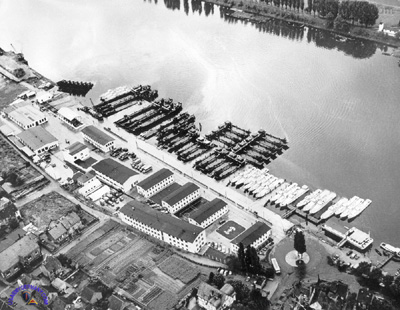
1. Aerial view of Schierstein (213 KB) |
|
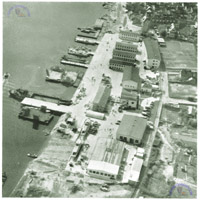
2. Aerial of Unit "S" at Schierstein, 1954 |

3. Schierstein Patrol base |
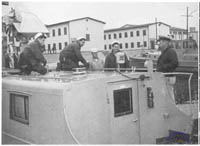
4. Unit S |
|
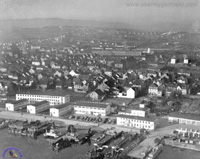
5. Schierstein |
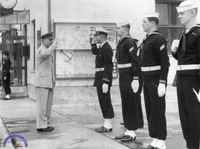
6. VIP visits Schierstein |
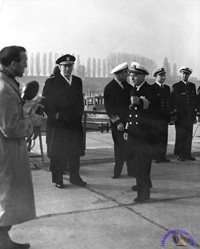
7. Capt Unmacht, RRP CO |
|
|
|
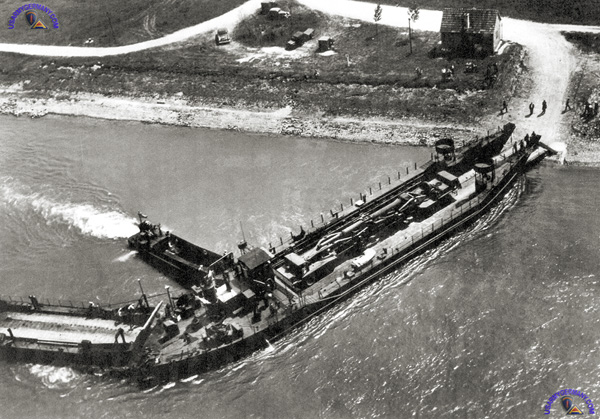
8. Aerial view of an LCU Mark IV ferrying a 280-mm gun
|
|
|
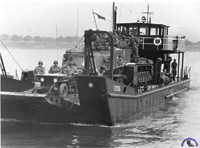
9. River crossing exercise |
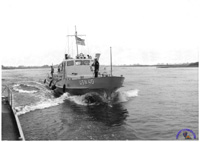
10. PR 40 |
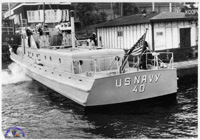
11. PR 40 |
|
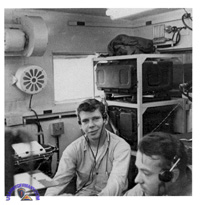
12. Don Birkes (KB) |
|
|
|
|
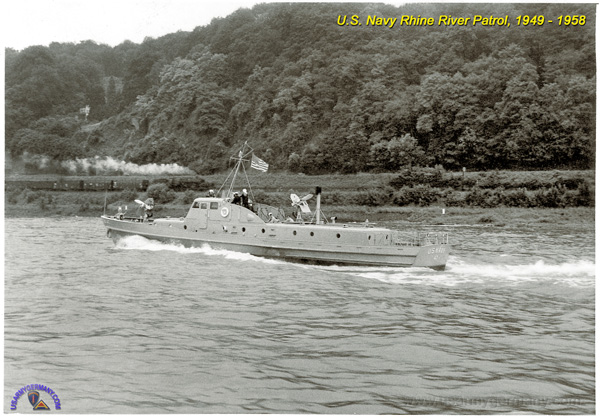
13. PR 41 on routine patrol on the Rhine River late 1950s (488 KB) |
|
| |
Unit "M"
Mannheim-Sandhofen
|
|
|
|
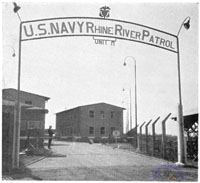
1. Main gate, Unit "M" |
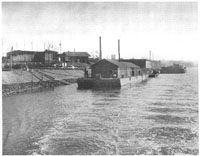
2. View of YHB at Unit "M" from the Rhine River |
|
|
|
| |
Unit "K"
Karlsruhe-Rheinhafen
|
|
|
|
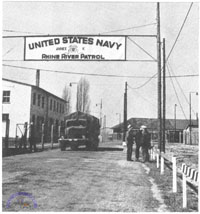
1. Main gate, Unit "K" |
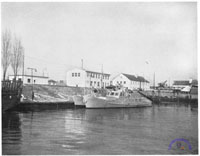
2. View of patrol base from harbor |
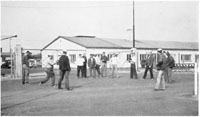
3. Unit "K" softball team |
|
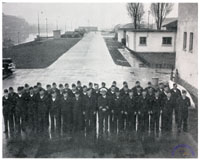
4. LSU Group, probably at Unit "K" |
|
|
|
|
| |
Patrol Craft
|
|
|
|
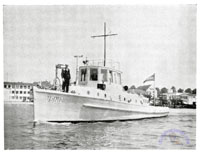
1. Patrol Craft, old |
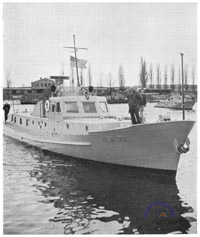
2. Patrol Craft, new |
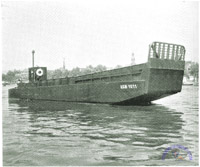
3. LCM (6) |
|
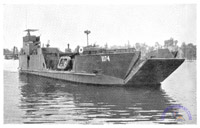
4. LCU Mark VI |
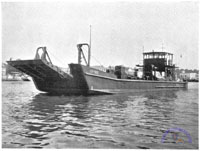
5. LCM (RR) |
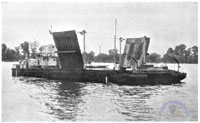
6. Siebel Ferry |
|
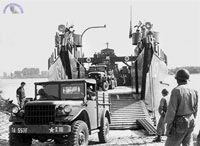
7. LCU Mark IV "1G" with Corporal missile |
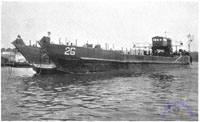
8. LCU Mark IV "2G" |
 9. LCU Mark IV "3G" with 280mm Gun 9. LCU Mark IV "3G" with 280mm Gun
|
|
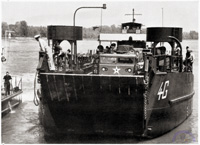
10. LCU Mark IV "4G" with 280mm Gun |
|
|
|
|
|
|
| (Source: STARS & STRIPES, Dec 13, 1954) |
The Rhine River Patrol is responsible for the security along a 120-mile stretch of the Rhine River (within the US Zone of Occupation) and for water communications of US and NATO forces. It is part of the US Naval Forces, Germany which is headquartered at Campbell Barracks, Heidelberg.
RRP is comprised of over 350 US Navy officers and men and 200 German sailors.
Some of the tasts performed by the Patrol:
  it checks all commercail traffic; vessels are logged by type and nationality. it checks all commercail traffic; vessels are logged by type and nationality.
  it keeps reports on river depths, channels and currents. it keeps reports on river depths, channels and currents.
  using shallow draft, medium landing craft (LMC (RR)), the patrol provides supplementary ferry duty; carries on salvage operations and fire control support. using shallow draft, medium landing craft (LMC (RR)), the patrol provides supplementary ferry duty; carries on salvage operations and fire control support.
  during field exercises by US or NATO allies, it uses LCMs (1) to trundle ground troops and materiel across the Rhine, maintains floating guards at bridges and carries out simulated demolitions as part of training diuties. during field exercises by US or NATO allies, it uses LCMs (1) to trundle ground troops and materiel across the Rhine, maintains floating guards at bridges and carries out simulated demolitions as part of training diuties.
  for patrols along the Rhine requiring greater speed, the unit uses 80-foot twin-screw PR (Patrol, Rhine) craft; they can reach top speeds of 27 knots. for patrols along the Rhine requiring greater speed, the unit uses 80-foot twin-screw PR (Patrol, Rhine) craft; they can reach top speeds of 27 knots.
Senior officers of the Patrol:
 Capt George P. nmacht, commanding officer of RRP. Capt George P. nmacht, commanding officer of RRP.
 Lt Cmdr R. C. Bush is in charge of Unit S (Schiertsein). Lt Cmdr R. C. Bush is in charge of Unit S (Schiertsein).
 Lt Cmdr Lloyd L. Bush is commander of Unit K (Karlsruhe). Lt Cmdr Lloyd L. Bush is commander of Unit K (Karlsruhe).
 Lt Cmdr James T. Schermerhorn is CO of UNit M (Mannheim). Lt Cmdr James T. Schermerhorn is CO of UNit M (Mannheim).
This past winter the Rhine River was frozen from bank to bank, curtailing navigation. Ships of the Rhine River Patrol pushed up and down the river in the US sector to keep lanes open for emergency trips. LCMs rescued many stranded commercial barges by towing them to harbor.
(1) The LCMs can carry a heavy tank or about 60 tons of cargo. The patrol also uses larger LCUs that can be sued to ferry the 280-mm atomic cannon.
|
|
|
| 1956 |
| (Source: Email from Donald Birkes) |
|
|
General information on the Rhine River Patrol and its mission prepared by the RRPAT Operations Officer in 1956
Page 1
Page 2
Page 3 |
|
|
|
| |
| 1957
- 1958 |
| (Source: Annual
Historical Report, 1957-1958, HQ USAREUR) |
Transfer of
the Rhine River Patrol Responsibilities
Toward the end of FY 1957 CINCNELM had indicated a desire to withdraw
US Naval personnel from the Rhine River; since the Rhine River Patrol's
lift capability was essential to USAREUR's operational plans, however,
the funds, personnel authorizations, and craft would have to be made
available to Seventh Army.
The only other alternative would be for West German military units
to assume the patrol and lift functions. In August 1957 the Chief
of Naval Operations directed that CINCNELM phase out the patrol functions
proper by 1 February 1958; the 21 patrol craft in use were to be declared
excess to the Navy's needs and turned over to the Federal Republic
of Germany. Moreover, the entire Rhine River Patrol would be disestablished
effective 30 June 1958, and the remaining lift craft would be turned
over to USAREUR if the Department of the Army so desired.
In September 1957 USAREUR began informal discussions with the German
Ministry of Defense, which had indicated its willingness to accept
the mission of the patrol. Simultaneously, Seventh Army was to determine
the type of interim organization that would be required to support
the phased transfer of responsibilities from the US Navy to West German
military units. The plan was to turn over the patrol function to the
German Army by 1 February 1958, the lift operation by 1 July 1958,
and the control element as soon as the Germans could fully support
USAREUR emergency plans -- presumably by the end of FY 1959.
Planning and negotiations continued apace, with close coordination
being maintained between USAREUR, Seventh Army, CINCNELM, the Rhine
River Patrol, and, of course, the representatives of the Federal Republic
of Germany. USAREUR's proposals were accepted by the Ministry of Defense,
and on 1 February 1958 the patrolling function -- together with 21
patrol craft -- was turned over by the US Navy to the German 791st
Engineer River Company under the operational control of the Rhine
River Patrol until the Patrol's disestablishment on 30 June. Continuing
discussions during February and March 1958 revealed that the German
engineer company would be able to assume only part of the lift function,
since it lacked sufficient strength to fully support Seventh Army's
requirements. Urgent appeals were made to the Ministry of Defense
to insure that loss of effectiveness would be minimized.
At the same time, a chain of command was developed and agreed upon
by USAREUR and the Ministry of Defense. In peacetime, the 791st Engineer
River Company would operate under the control of the IV German Military
District (WBK IV), which would coordinate with the US Seventh Army
on all matters pertaining to exercises, alerts, and communications
checks. In wartime -- after OSA, ORA, or GAO -- the German company
would come under the direct operational control of Seventh Army for
all matters pertaining to that Army's lines of communications across
the Rhine. The Seventh Army was directed to establish and maintain
liaison with WBK IV, effective 30 June 1958.
By the end of May the German engineer company had been brought up
to full strength, although the degree of training achieved indicated
that full operational readiness equivalent to that of the Rhine River
Patrol would not be attained by 30 June. Nevertheless, on 30 June
1958 the 791st Engineer Company assumed responsibility for the lift
mission of the former Rhine River Patrol; 16 medium landing craft
(LCMRR), 1 flying ferry at Schierstein, 1 houseboat at Mannheim, and
the 3 Rhine River bases at Karlsruhe, Mannheim, and Schierstein were
turned over to the German unit. The remaining equipment -- consisting
of 4 British LCM's, 2 dollar-procured LCT's, and 6 tugs, which the
Germans did not want -- was disposed of by the US Navy. |
| |
| If you have more
information on the history or organization of the Rhine River Patrol,
please contact me. |
 |
|
| |
| U.S. Naval Forces, Germany Headquarters |
| |
| (Source: STARS & STRIPES, April 22, 1951) |
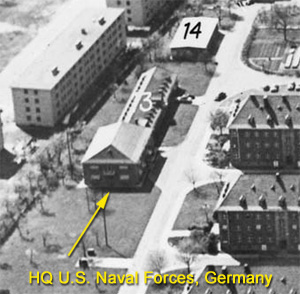
HQ USNAVGER |
|
On April 21, 1951, Rear (two-star) Adm John E. Wilkes, Cmdr US Naval Forces, Germany, turned over command of the Naval Forces in Germany to Rear Adm Carl Holden in a ceremony held at Campbell Barracks, Heidelberg, home station of COMNAVGER.
COMNAVGER recently moved from Berlin to Heidelberg, establishing his headquarters in Bldg 13 (see photo).
The main operations of the US Navy in Germany include
 Bremerhaven Advanced Naval Base Bremerhaven Advanced Naval Base
 Rhine River Patrol Rhine River Patrol
In addition, the Intelligence Detachment (still in Berlin) maintains offices in Berlin, Frankfurt, and Munich.
|
|
Originally, the mission of the US Navy in Occupation Germany was purely administrative - it was responsible for overseeing the parcelling of Germany's naval and merchant marine assets among the victorious allies. Once that mission was completed, plans called for closing out all of the Navy units in Germany.
Gen Lucius D. Clay (EUCOM CG at the time) and Rear Adm Wilkes (who had arrived in July 1948 to assume his current assignment) convinced Washington to keep some naval forces in Germany. |
| |
|
|
The most important mission of USNAVGER is to provide security of inland waterways in its area of responsibility. The Rhine River Patrol is the unit that performs that mission within the US Occupation Zone in Germany.
The Navy also licenses all US private craft operating on the Rhine, other inland waterways in the US Zone and on lakes, including the Wannsee in Berlin.
(Webmaster Note: The organizational chart on the left is from the Command Report EUCOM-USAREUR from 1952 and shows the organization of USNAVGER at the end of 1952.) |
|
|
 |
|
| |
| Communications Unit 8, Bremerhaven |
| |
| (Source: Personal memoris by Mel Prokity, Naval Advanced Base Bremerhaven) |
|
|
Personal memoirs written by a US Navy vet who served with Communications Unit 8 (US Navy) at the Naval Advanced Base in Bremerhaven in 1954. Very interesting narrative with lots of details that illustrate the life of a sailor in Bremerhaven in the waning days of the Occupation.
NOTE: Mel's memoirs are saved in a rich text format (RTF) to allow you to open the files in most desktop publishing programs. Careful - this is a large file - 11+ MB) |
|
|
 |
|
| |
| Unit S ("Sugar"), Schierstein (Wiesbaden) |
| |
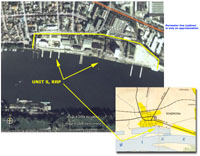
Unit S Compound ( ) )
|
|
|
|
| |
| (Source: Author's collection) |
| Schierstein |
|
|
|
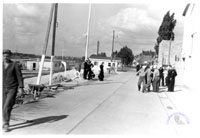
1. Schierstein |
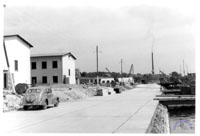
2. Schierstein |
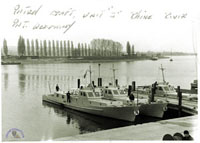
3. Unit S |
|
|
| Can anybody provide more details on the photos or the unit? |
|
| |
| (Source: Email from Donald Birkes) |
I served in CORRPAT - Schierstein 1955-1957 as a radioman, RM2.
I am still very much involved with four of my shipmates from CORRPAT at Schierstein.
Click here to see the photos Don submitted. |
 |
|
| |
| Unit M ("Mike"), Sandhofen (Mannheim) |
| |
| (Source: Email from Harland G. Voigt, Jr.) |
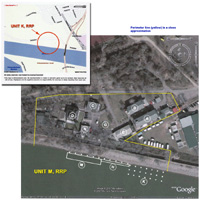 Unit M Compound (
Unit M Compound ( ) )
|
|
Sandhofen Compound
I was attached to Unit M from 1954 to 1956. I have a few photos if you are interested. Also, there are pictures on Google Earth that show the location of the base.
The buildings, except for the ammo bunker, are still there. The pilings and the floats are gone. I have, somewhere, a few photos a friend took when he was on a visit to the area about ten years ago. If I find them, I'll send you copies.
I'm sure glad someone like yourself is establishing a history of the Patrol. It was unique, But, so few have even heard of it. Even the Navy has ignored it. |
|
|
| |
| Mannheim-Sandhofen |
|
|
|
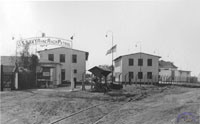
1. Unit M, Sandhofen |
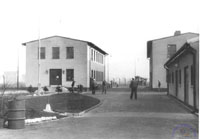
2. Sandhofen |
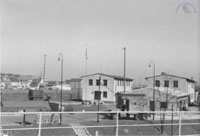
3. Sandhofen |
|
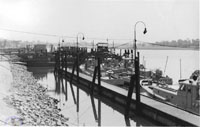
4. Sandhofen |
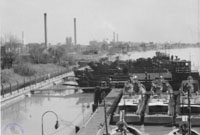
5. Sandhofen |
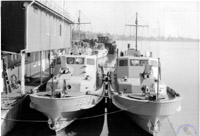
6. '33 Class' PR's |
|
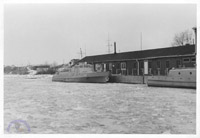
7. PR-34 at the fuel station |
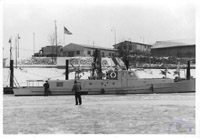
8. Sandhofen |
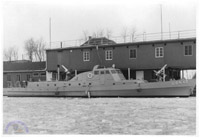
9. '33 Class' PR alonside the barge |
|
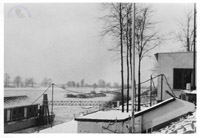
10. Sandhofen |
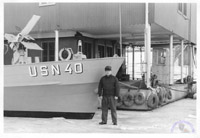
11. PR-40 |
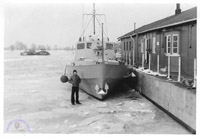
12. PR-34 |
|
|
 |
|
| |
| Unit K ("King"), Rheinhafen (Karlsruhe) |
| |
| (Source: Email from George Dukes, RRP, 1956-57) |
I was stationed at Karlsruhe (Unit "K" -  ) from Nov 1956 until 1 August 1957. My first craft was PR-9 until it was scrapped. This was a temporary assignment, I was originall assigned to PR-21 but it had run aground while I was arriving at Bremerhaven. So for 6 months, I was assigned with BM1 McDuffy while Schierstein was fixing PR-21. In the eman time I attended the Engine and Ordnance School. ) from Nov 1956 until 1 August 1957. My first craft was PR-9 until it was scrapped. This was a temporary assignment, I was originall assigned to PR-21 but it had run aground while I was arriving at Bremerhaven. So for 6 months, I was assigned with BM1 McDuffy while Schierstein was fixing PR-21. In the eman time I attended the Engine and Ordnance School.
In October 1955, I went from FN to Pipefitter 3rd and given PR-27 with Clarance Pettersen EN2.
In 1957, I heard that after the Germans got their country back we would be leaving. I re-enlisted for additional 6 years and asked for sea duty. I really hated to leave but I did not want to be part of the change over. |
|
| |
| Karlsruhe Rheinhafen |
|
|
|
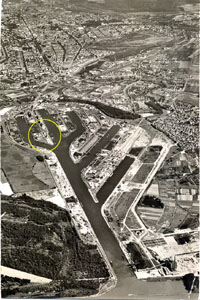
1. Rheinhafen |
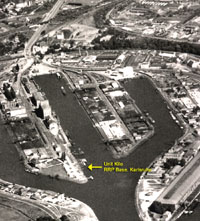
2. Unit K, RRP |
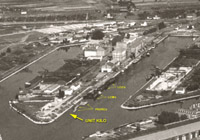
3. Unit K, RRP |
|
|
 |
|
| |
| Labor Service Unit |
| |
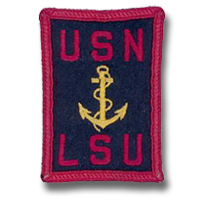 Labor Service Unit Patch Labor Service Unit Patch |
| |
| Labor Service Unit "C" |
| |
| (Source: Letter from Max Strässner, LSU "C", 1954-1965) |
I was a member of Labor Service Unit "C" and later the 8542nd CLG between 1954 and 1965. In hindsight, I must say that service in the LSU was much better than later under the Civilian Labor Groups. For example: the Wiesbaden Navy base (Schierstein) had a small dispensary with two doctors (one US and one German). There was a movie theater that showed a movie every night. The mess hall food was excellent with a lot of variety. Billets were large, well kept and very sanitary. Pay was very good for the 1950s.
Life was good and there was a lot of comradery among the members of the LSU. So, the end of the LSU (with the transition of the RRP mission to the German Bundeswehr) seemed like the end of the world to us.
After I was transferred to the CLG I did not see the same comradery. After
duty hours the kaserne was empty, everybody went their own way.
I have many memories from my time with the LSU and CLG - most are good, some not so great. ButI would not have missed my time with those units. A great and eventful experience. |
| Karlsruhe Rheinhafen |
|
|
|
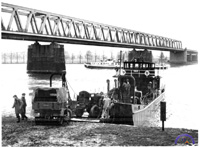
1. Ferrying farm equipment |
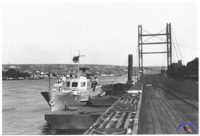
2. USN 29 alongside a swing bridge |
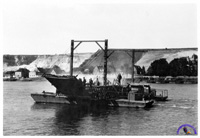
3. Class 100 heavy raft |
|
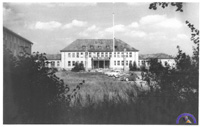
4. 8542nd CLG |
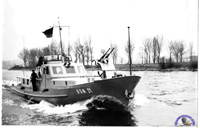
5. USN 21 |
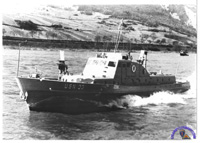
6. |
|
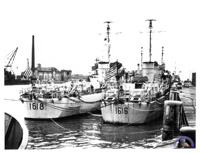
7. Sub chasers at Bremerhaven |
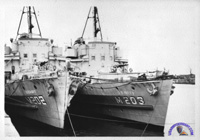
8. "M" boats |
|
|
|
 |
|
| |
| Newspaper
Articles |
|
ARMY,
NAVY & AIR FORCE JOURNAL
Washington,
D.C., 13 November 1954
Vol. LXXXXII, No. 11
|
| |
|
"SALTLESS
NAVY" BUSY
|
| |
| The US
Navy Rhine River Patrol - 300 miles from the nearest salt water
- was visited by Navy Secretary Charles S. Thomas during his
recent tour of Europe.
RAdm Bertram
J. Rodgers, USN, Commander of US Naval Forces in Europe, accompanied
the Secretary from USAREUR headquarters at Wiesbaden1) to
the USNRRPAT base at Schierstein where he inspected the base
and made a trip aboard a patrol vessel down to the famed Rock
of the Lorelei.
Secretary
Thomas expressed his pleasure at seeing one sharp, shipshape
installation and what is probably one of the Navy's most unusual
activities. His host at Schierstein was Capt G. P. Unmacht,
USN, commander of the USNRRPAT.
The base
is near the north end of the American sector of the Rhine
which extends about 120 miles from Lauterbourg2) in the south
to Lorch in the north. The French patrol other sectors above
and below the US sector. In addition to the headquarters and
Unit "S" at Schierstein, the US Navy also has a
base, Unit "K," at Karlsruhe near the southern end,
and Unit "M" at Sandhofen, near Mannheim. The Schierstein
base is completely equipped for repair and overhaul of engines,
vessels and equipment.
The patrol
is primarily a tactical arm and is responsible for the security
of the US Zone of Germany along the Rhine and for the water
communications of the US and NATO forces.
It also
checks all commercial vessels and logs them as to type and
nationality. More than 8,000 were recorded last year.
The patrol
is working constantly with the US Army and Air Force, assisting
them in their maneuvers and exercises. In recent exercises
the patrol ferried more than 13,000 personnel across the Rhine,
more than 500 tanks, 133 artillery pieces, and 4,800 miscellaneous
vehicles. It has frequently transported the Army's huge 280-mm
atomic cannon.
In addition,
shore based personnel of the patrol, led by Captain Unmacht
and his executive officer, Capt W. R. Gebert, USN, take to
the field with the Army in command post exercises. These take
place about once every two months.
The Navy
also carries amphibious boats with the Army on its maneuvers,
ready to take men and supplies across the many rivers of Europe.
Admiral
Rodgers, told THE HOURNAL, that it is the Navy's prime function
in Germany to assist and work with the Army in every possible
way. "It is a welcome duty," he said, "for
the US Army in Europe is a finely trained, crack force, ever
ready for combat."
In addition
to the Rhine River Patrol, Admiral Rodgers also has under
his command the Navy's installations and vessels at Bremerhaven.
An important activity there is mine sweeping. The US Naval
Advanced Base there is commanded by Capt J. G. McLaughry,
USN.
Both the
Rhine Patrol and the Bremerhaven operations make heavy use
of German personnel. Many of these served in the former German
units, but an increasing number is being drawn from young
Germans anxious for a career at sea. In many instances German
crews and officers are in complete control of vessels on patrol
or on mine sweeping details. They are not, however, permitted
to operate vessels equipped with guns or automatic weapons.
When the
new German Navy provided under the London agreement gets underway,
it is likely that large numbers of American trained German
seamen and officers will be taken in. US leaders hope that
this will be done, for they feel that their work with the
combined fleets will be greatly facilitated by their American
training. On the other hand, they also hope that they will
not all go over to the German navy at once, but rather in
increments, for they are a valuable part of our activities
and we would rather have a transition period during which
we can recruit and train more Germans to take their places.
The US
seamen serving with our units in Germany are a hand-picked
group. All have asked for the duty and then are thoroughly
screened before being assigned. Each man picked must have
had a conduct score of 4.0 (perfect) for at least one year
prior to selection.
Like other
US Forces in Germany, the Rhine River Patrol has done much
to help the German people. Recently when LCdr M. J. Gates
was detached for duty in the States the Oberburgermeister
of Karlsruhe sent an official letter thanking him for the
help and cooperation he had frequently given the German people
there. Also recently Captain Unmacht received a letter from
a Catholic priest expressing appreciation for the use of a
navy crane and bulldozer which helped in the rebuilding of
their church and playground. These are instances which are
multiplied many times over during the year.
|
|
Comments
by webmaster:
1) US Army, Europe (USAREUR) headquarters was
actually located at Heidelberg. Wiesbaden was headquarters for
the US Air Force in Europe.
2) Lauterbourg (France) is located on the French-German border
and lies just southwest of Karlsruhe. |
|
|
| |
|
ARMY
INFORMATION DIGEST
(January)
1954
Vol. 9, No. 1
|
| |
|
The
Navy Watches On the Rhine
Captain
B. A. Robbins 1)
|
| |
| The legendary
Rhine Valley is today a fascinating operations area for hundreds
of American sailors. These mariners, serving more than three
hundred miles from the nearest salt water, are members of one
of the United States Navy's most unusual flotillas - the Rhine
River Patrol.
Primarily
a tactical arm, the Patrol is responsible for the security
of the United States Zone of Germany along the Rhine and for
the water communications of United States and North Atlantic
Treaty Organization forces. Its mission is to control river
traffic from Lauterbourg in the south to Lorch about a hundred
miles north. Lauterbourg, the upstream terminus, lies at the
border of the French Zone and at the head of the Black Forest.
Lorch, deep in the heart of the castle country downstream,
is close to the famed Rock of the Lorelei and thirty-five
miles from Coblenz, headquarters of American occupation forces
after World War I.
The Rhine
is one of the world's busiest inland waterways. It is estimated
that about eighty-eight million tons of cargo will move up
and down the river during the year, placing its tonnage well
above that of our own Mississippi. The biggest single item
of commerce is coal from the Ruhr Valley. Some twenty-eight
million tons will be shipped this year.
It is
the job of the Patrol to check all commercial vessels and
log them as to type and nationality. Over eight thousand were
recorded in 1952. At the same time, the Patrol notes and reports
changes in currents, channels and river depths. Our sailors
have learned that there are no short cuts to mastering river
navigation. High water from the snowy Alps frequently causes
trouble. The swift, changing currents gouge and alter the
underwater topography, leaving new channels which must be
designated on navigation charts.
Shorelines
are troublesome, too. They have been lined with paving stones
placed there by the Germans to protect the land from washing
away in high water. To avoid damage, landing craft must be
handled carefully when loading or unloading.
Besides
controlling commercial traffic along the American sector of
the Rhine, the Patrol protects bridges and other structures,
provides supplemental ferry service, carries on salvage operations
and fire control support. During United States-Allied field
exercises, the Patrol ferries ground troops and materiel across
the Rhine, maintains floating guards at bridges, and occasionally
carries out simulated bridge demolitions as part of its training
duties.
The Rhine
is not a new sphere for the Navy. During World War II assault
and landing vessels with Navy crews were hauled overland from
Channel ports on the Atlantic and launched from the west bank
of the Rhine. After the war the Navy withdrew and did not
return until 1948. In December of that year the Rhine River
Patrol was established.
Today
the Patrol has three operating sections. Headquarters and
Unit "S" are at Schierstein, a harbor community
close to Wiesbaden. Unit "K" is at Karlsruhe near
the southern terminus. The third, Unit "M", is based
at Sandhofen near Mannheim.
Several
types of craft are used. Newest and fastest are the 80-foot,
twin-screw speedsters called PRs (Patrol, River). By degrees
these are replacing the old German torpedo-retriever boats
(torpedofangboot) which the Patrol has been using. With a
top speed of 27 knots, the new silver-gray craft were built
in German shipyards to US Navy specifications. Plans called
for an underside exhaust and no stack, but the German boat
builders were more than skeptical. "They were amazed,"
one of our Navy men recalls. "They didn't think it could
be done because they had never done it before. But we told
them that in America vessels with underside exhausts and no
stacks are common. We finally got the boats without the stacks."
Work horses
of the patrol are the LCUs (Landing Craft, Utility), formerly
British craft, which are used chiefly for ferrying operations.
They can transport five heavy tanks or two hundred and fifty
tons of cargo. During Seventh Army field exercises the LCUs
ferry vehicles and troops across the river.
Two other
types of smaller ferrying craft are in use. The LCM (Landing
Craft, Medium) can carry one medium tank or about thirty tons.
Slightly larger than the LCMs are the LCM-RRs (Rhine River)
which were constructed in Germany under US Navy direction.
Built to meet the peculiar requirements of the Rhine River
shoreline, the LCM-RRs can carry one heavy tank or sixty tons
of cargo.
Ferrying
operations keep the patrol busy. During Army and Air Force
training exercises, the major loads are bulldozers, trucks,
bridge building equipment, and supplies. Allied vehicles,
too, are accommodated. In one recent operation the patrol
shuttled a large number of French Army tanks and trucks across
the waterway.
Special
ferrying tasks are handled by an awkward-looking craft known
as the Siebel ferry. Built by the Nazis to carry tanks on
the Mediterranean and on Italian rivers, they are self-propelled
rafts with parallel pontoons, planked decks and retractable
loading ramps on two sides.
Crews
vary according to the type of patrol vessel. The fast PRs
have an all-US Navy crew of five commanded by a boatswain's
mate first class. Each LCU carries a 16- to 22-man mixed US
Navy and German crew. The Germans are members of the Labor
Service Organization and many of them once served in the German
navy. Each unit of the Patrol includes a contingent of these
Germans qualified in marine skills.
During
the Netherlands floods of February 1953, the Patrol earned
the gratitude of the stricken Dutch. Like other United States
military services in Germany, the Patrol did its share to
relieve suffering in the flooded areas. Two PRs and two LCUs
helped with the rescue of persons and livestock. For almost
a month the four boats aided the Hollanders in supply and
reconstruction work.
Duty with
the Rhine Patrol involves continuing travel through some of
the finest tourist attractions in Europe. The picturesque
Rhine Gorge, with its hillside vineyards, crumbling castles
and gingerbread villages, has a thousand legends. One of them
tells of the siren on the Rock of the Lorelei who sings of
the natural beauty around her while combing her golden hair.
It is no wonder that an enraptured Rhine skipper might look
up too long and let his barge shoal up on a hidden reef. The
Gorge is the kingdom of the grape and in many languages Rhine
rhymes with wine, Rhin with vin and Rhein with Wein.
Above
the vineyards, the cragged castles still beetle down on the
rococo towns and the river as they did in the days when their
robber-baron owners levied tribute from passing vessels. Some
of the freebooters built their "tollhouses" right
in the middle of the Rhine. The Mouse Tower, built on a quartz
rock near Bingen Loch, was one of these hold-up points. Later
legend tells of the fate of a cruel-hearted tyrant in the
tenth century who tried to solve a famine by burning the poor
in a barn. According to the legend, he was pursued into the
tower by thousands of indignant mice and devoured alive.
To make
their "seafaring" life more unusual, the crews of
the Rhine River Patrol are armed with carbines, carry full
field packs on occasion and take turn rustling up meals when
their vessel is on a lengthy river patrol. The duty is not
all hurricane decks, navigation and channel soundings either.
The men receive considerable land training and their 42-man
frill team, one of the finest in the European Command, represented
the Navy at the Armed Forces Day observances at the Olympic
Stadium in Berlin. Many consider the Rhine River Patrol choice
duty and there is always a waiting list of applicants. It
may lack some of the glamour of the high seas but it has many
attractions.
|
| |
FOOTNOTE:
1) Captain
B. A. Robbins, USN, was formerly Commanding Officer of the Rhine
River Patrol. |
| |
|
|
|
|
EUROPEAN
COMMAND
ANNUAL NARRATIVE REPORT
1 January
- 31 December, 1949
|
| |
| CHAPTER
II. Major Organizational Changes in the European Command |
| |
25.
Other Actions Tending Toward Unified Command
While these step were being taken at a high level
to formulate a policy for the Command on unification, other
individual steps were also being taken to actively bring about
unification for the more efficient operation of the Command.
a. The Rhine River Patrol. On 23 December 1948 the Commander,
US Naval Forces, Germany (COMNAVFORGER), was directed to establish
a Rhine River Patrol, to operate from Bingen to Karlsruhe, and
to be jointly manned by Naval and Constabulary personnel. (51)
Subsequently, a letter from EUCOM Headquarters enlarged upon
this original message, delegating the responsibilities for the
patrol operation normally to the COMNAVFORGER but, in time of
emergency or temporarily, as during manuevers, to the Commanding
General, US Constabulary. The letter further indicated the make-up
of crews. There were to be eight crews of seven men each, crewmen
to be provided by the Navy, while the Constabulary would provide
three extra crewmen for each crew (one machine gunner and a
2-man demolition team). The Navy was made responsible for the
joint training of the crews with the Constabulary responsible
only for the training of its personnel in demolitions and use
of machine guns. Missions were of a patrol and intelligence
nature. The logistics support of the patrol would be by the
Navy, by military posts at which the patrol might be based,
and, in event additional support were necessary, through the
Logistics Division, EUCOM Headquarters, by direct requisition.
(52)
|
| |
51.
Cable, SX-4422, EUCOM to COMNAVFORGER and CG, US Constab, 23
Dec 49.
52. Ltr, EUCOM to CG, US Constab, COMNAVFORGER, 23 Mar
49, sub: Training and Operation of the Rhine River Patrol, AG
353 GOT - AGO. |
| |
| CHAPTER
VII. Relations with US Naval Forces, Germany (USNAVFORGER) |
|
3. Rhine
River Patrol
a. Establishment of Patrol.
The Rhine River Patrol was activated in March as an inland water
patrol under the command of the Commander US Naval Forces, Germany,
with certain US Constabulary personnel attached. The creation
of this command was authorized in December 1948 when COMNAVFORGER
was directed to establish a Rhine River Patrol to operate from
the vicinity of Bingen to Karlsruhe, Germany. The patrol consisted
originally of eleven craft - one air-sea rescue craft and ten
TF's (German Torpedo Recovery Boats). Naval strength for the
patrol was composed of eight crews of seven men each and a small
command group. The US Constabulary supplied three additional
men per crew, one machine-gunner and a two-man demolition team.
(8) This personnel breakdown and the inland nature of the patrol
was indicative of the co-operation between EUCOM and USNAVFORGER
in 1949.
b. Control, Administration, and Support. Although COMNAVFORGER
was charged with the normal command responsibility for the patrol,
the Commanding General, US Constabulary, was to assume operational
control in the event of an emergency. Administratively, there
was complete co-operation between EUCOM and USNAVFORGER. Requests
for facilities, services, and supplies (less organizational
equipment) which could not be met by the Navy, Wiesbaden Military
Post, or other posts on which the Patrol might be based, were
submitted to the Logistics Division, EUCOM Headquarters, together
with estimated costs. The major requests made through the Logistics
Division during 1949 were for funds for construction of a cinder
block-house and for conversion of a barge for billeting and
offices. In addition, COMNAVFORGER submitted to the OPOT Division
through the US Constabulary a request for certain items of organizational
equipment not provided by the Navy. The OPOT Division published
an Equipment Modification List covering the needs of the Rhine
River Patrol and authorized the 54th Engineer Combat Battalion
to draw this equipment for use by the Patrol on a loan basis.
The materiel supplied consisted of engineer, ordnance, and signal
equipment. (9) The Patrol also submitted recommendations for
a basic load of ammunition, which was established on 13 January
1950 (10), and for training requirements necessary to accomplish
its mission. In each case action was taken by the Requirements,
Organization, Equipment, and Movements (ROEM) Branch of the
OPOT Division and by the Logistics Division, EUCOM Headquarters.
c. Operations of the Patrol. Although the major activity
of the patrol in joint operations was its participation in Exercise
HARVEST, it also took part in a joint maneuver by the
US Constabulary and the French Army of Occupation in late September.
In this maneuver, the Rhine River Patrol moved elements of the
1st Armored Cavalry Brigade across the Rhine River. During the
year, it also engaged in Command-level training, routine patrolling
of the Rhine, setting up supply channels through EUCOM installations,
and maintaining close liaison with military posts on which its
units were based. (11) |
|
8.
Ltr, EUCOM to CG, Constabulary; COMNAVFORGER, 23 Mar 49, sub:
Training and Operation of the Rhine River Patrol, AG 353 GOT
- AGO.
9. Ltr, EUCOM to CG, US Constabulary, 21 Jan 50, sub:
Temporary Loan of Equipment, Rhine River Patrol, AG 400.4 GOT.
10. Ltr, EUCOM to CG, USAREUR and COMNAVFORGER, 13 Jan
50, sub: Basic Load (ClassV) for US Navy Rhine River Patrol,
AG 471 GOT - AGO.
11. Interv, George R. Kaplan, Hist Div, with Lt I. W.
Matthews, USN, Rhine River Patrol, 15 Feb 50. |
|
|
| |
 |
| (Source: STARS & STRIPES, February 2 1958) |
Germany Takes Helm Of Rhine Patrol Craft
by BRENDAN P. MULREADY
SCHIERSTEIN. Germany (S&S)
Patrol craft of the U.S. Navy's Rhine River Patrol were turned over to the West German Army here in formal ceremonies attended by officials of the U.S. and Germany.
The transfer of 21 patrol craft to Germany marked another step in the gradual phaseout of the U.S. Naval operation on the Rhine River which has been conducted since 1949. By the end of June, it is anticipated that the last U.S. Naval personnel will have departed the Rhine River assignment.
Capt Axton T. Jones, commander of the patrol said the craft "will continue the job of patrolling the 320-mile sector of the Rhine River from Lauterburg to Lorch, but now flying the flag of the Federal Republic of Germany."
Accepting the craft for the German government was Lt Col Wilhelm Schwarz, CO of the German Army's 706th Engr River Regt at Coblenz
He told the German officers and enlisted men: "You must live up to your new mission . . . and take over this task on the Rhine River with the same sense of duty and with the same efficiency as members of the U.S. Navy."
"The comradelike aid, the cooperation between Germans and Americans on board the craft and at the bases have demonstrated how much nearer our two peoples have approached each other, and that both nations serve a mutual cause safeguarding our freedom."
Following the addresses by Jones and Schwarz, Cmdr Jack E. Halter, Jr., patrol executive officer, ordered: "Haul down the United States colors." Slowly and in unison, the Stars and Stripes came down on the patrol craft for the last time.
As the German flag snapped into place, the 50-piece band of the IV German Military District at Mainz, played the German national anthem. This was followed by the "Star Spangled Banner," rendered by the 443d AAA Bn. from Wiesbaden Air Base.
The ceremony was closed by a brief benediction by Lt William J. Barragy, 443d AAA Bn chaplain.
Guests included Maj Gen Gordon B. Rogers, 7th Army Deputy CG; Capt Bernhardt Biederbick, representing Vice-Adm Friedrich O. Ruge, German chief of naval operations; German Army Col Kurt Lehnert; Capt Albert P. Scott, U.S. Naval Attache at Bonn; Navy Capt Hugh Q. Murray, USAREUR; Air Force Col James A. Price, commander of the 7100th Support Wing, and Col Robert H. Van Volkenburgh, Jr., CO of the 34th AAA Brig.
The patrol craft will be manned by German Army crews under operational control of the U.S. Navy until June 30. In the interim, landing craft used for transporting troops, equipment and cargo, will be turned over to the Germans. Rhine River Patrol bases at Mannheim and Karlsruhe are in process of being phased out - Mannheim, March 1, and Karlsruhe, April 1. |
 |
|
| |
Related Links:
US
Navy in Germany - A Yahoo Group hosted by veterans of the
Rhine River Patrol, Weser River Patrol, USNAB Bremerhaven, COMNAVGER
Die Flusspioniere - a reunion web site for the German Army's engineer river units. These units assumed the mission and, to some extent, the equipment of the US Navy's Rhine River Patrol, the French
Forces Maritimes du Rhin (Koblenz) and the British
Royal Navy Rhine Flotilla (Krefeld).
Die Flusspioniere der Bundeswehr - a page on the excellent Panzerbaer.de web site. Wiesbaden-Schierstein vets might be interested at looking at the page for a nice photo of the Schierstein compound shortly after it was taken over by the German Bundeswehr.
Forerunners of the West German Bundesmarine: The Klose Fast Patrol Group, the Naval Historical Team, Bremerhaven and the US Navy's Labor Service Unit (B)", Dr. Douglas Peifer, International Journal of Naval History, Vol. 1, No. 1 (online copy)
Minesweeper - A very nice page; Chapter 4 - More on the Labor Service Units - especially LSU (C) which supported the Rhine River Patrol
 Les Forces Maritimes Du Rhin - several pages of pictures showing various French patrol craft used by the French FMR unit, counterpart to the Rhine River Patrol. Includes a photo of their southern base at Kehl, Germany. Les Forces Maritimes Du Rhin - several pages of pictures showing various French patrol craft used by the French FMR unit, counterpart to the Rhine River Patrol. Includes a photo of their southern base at Kehl, Germany. |
| |
|

 Labor Service Unit Patch
Labor Service Unit Patch 